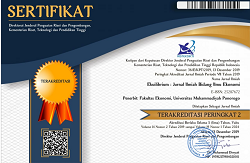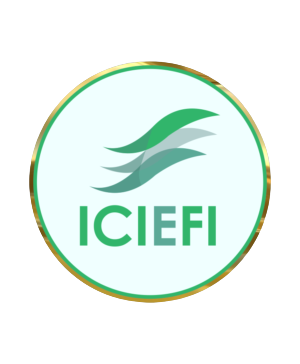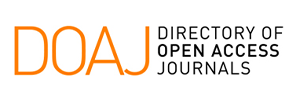Analysis of the Impact of Tourism on Economic Growth of Gunung Kidul District
DOI: 10.24269/ekuilibrium.v17i2.2022.pp182-189
Abstract
Tourism is one sector that affects economic growth. High economic growth is expected to provide a trickle-down effect on the development process in an area through the expansion of job opportunities, increasing the income level of the community so that it can ultimately reduce the poverty level. This research uses Mixed Method Research. The reason the researcher chooses this method is because using quantitative and qualitative approaches simultaneously (combined) can provide a better understanding of the research problem than being used separately. The results showed that tourist visits and the number of restaurants partially had no significant effect on the economic growth of Gunung Kidul Regency. This is influenced by the time series data used are still in the short term, the number of tourist objects partially has a positive and significant effect on economic growth in Gunung Kidul Regency.
Keywords
Tourism; Tourist Visits; Restaurants; Attractions; Economic growth
References
- A.W. Marsum. (2005). Restaurants and All Its Problems. Edition Four. Yogyakarta: Andi.
- Blake DR, Robson P, Ho M, Jubb RW, McCabe CS. Preliminary assessment of the efficacy, tolerability and safety of a cannabis-based medicine (Sativex) in the treatment of pain caused by rheumatoid arthritis. Rheumatology 2006;45:50–2.Brida et al: 2010. The Tourism-Led-Growth Hypothesis for Uruguay. Tourism Economics. Published by IP Publishing. Print ISSN: 1354-8166.
- Bojanic, DC & Lo, M. (2016). A comparison of the moderating effect of tourism reliance on the economic development for islands and other countries.Tourism Management, Vol.53, p.207-214.
- Daniel, Moehar. 2002. Socio-Economic Research Methods. Jakarta : Bumi Script.
- Eshlikii, S.A. & Kaboud, M., 2012. Community Perception of Tourism Impacts and Their Participation in Tourism Planning: A Case Study of Ramsar, Iran.
- Hasibuan, SP Malayu (2005). Human Resource Management. Revised Edition. Jakarta: Earth Literacy.
- Rahma, Fenny Nadia dan Herniwati Retno Handayani. 2013. The Influence of the Number of Tourist Visits, Number of Tourist Objects and Per capita Income on Tourism Sector Revenue in Kudus Regency. Diponegoro Journal of Economics Vol 2 No 2 of 2013.
- Great. Yoeti, Oka A. 1996. Introduction to Tourism. Bandung: Angkasa Offset
- Anggita Permata. (2019). The Influence of the Tourism Sector on Economic Growth in Indonesia. Surabaya.
- Hermawan, 2016. The Impact of Langgeran Tourism Village Development on the Local Community Economy. Tourism Journal, Vol.III No. 2 September 2016.
- Hsieh, H.-J. & Kung, S.-F., 2013. The Linkage Analysis of Environmental Impact of Tourism Industry. Procedia Environmental Sciences. 17, pp.658-665.
- Hsieh, Ming-Hue., Shan-Ling and Pan Rudy Setiono. 2004. Product-Corporate-and Country-Image Dimensions and Purchase Behavior: A. Multicountry Analysis. Journal of the Academy of Marketing Science, Vol. 32 No. 3 Pg 251-270.
- Lee, SH, Chang, SC, and Hou, JS, 2008. Night Market Experience and Image. International Journal of Culture, Tourism and Hospitality Research, 2(3), 217-233. http://dx.doi.org/10.1108/17506180810891591.
- Masrizal, 2011. Mixed Method Research. Jurnal Kesehatan Masyarakat. Vol.6, No. 1. https://doi.org/10.24893/jkma.v6i2.89.
- Marpaung, F. (2009). Regional Development Strategy as a Tourist Destination: A Case Study of the Gabusan Art Market in Bantul Regency, Unpublished Master's Thesis, Yogyakarta: Master of Tourism Studies Postgraduate School UGM.
- McKinnon, DW (1964). The Nature and Nature of Creative Talent. American Psychologist, 17 (7).
- Moleong, Lexy J. 2006. Qualitative Research Methodology. Bandung : PT Pemuda Rosdakarya.
- Nizar, M. A. (2011). The Effect of Tourism on Economic Growth in Indonesia. Indonesian Tourism Journal, 6(2), 195 – 211.
- Pendit, Nyoman S. 2003. Tourism Science an Introduction. Jakarta.
- Pitana, I G., Gayatri, PG. (2005). Tourism Sociology. Andi: Yogyakarta.
- Sakai, 2006. Theory, Culture & Society. Sage Journals. Volume 23, Issue 2-3. https://doi.org/10.1177/0263276406063778.
- Sopa Martina. 2014. The Impact of the Management of Kawah Putih Nature Park on the Social and Economic Life of the Community.
- Spillane, 2004. Historical Tourism Economics and Prospects. Yogyakarta: Kanisius.
- Subanti, 2011. Measurement of the Economic Value of Historical & Natural Tourism Objects (Case Study: Gedong Songo Temple, Semarang Regency). Mathematics and Character Education in Learning. Prosiding Seminar Nasional Matematika dan Pendidikan Matematika 2011. ISSN 978-979-16353-6-3.
- Suwantoro Gamal. 1997. Fundamentals of Tourism. Publisher Andi Yogyakarta.
- Sugiyono. 2007. Administrative Research Methods. Bandung: Alphabeta.
- Spurr, SH and BV Barnes. 1980. Forest Ecology. 3rd ed. John Willey and Sons. New York.
- T. Pradnya Paramita. Pitana, Igde et al. 2009. Introduction to Tourism Science. Yogjakarta.
- Andi Singgih Santoso, Parametric Statistics Exercise Book. Jakarta: PT. Elex Media Komputindo, 2005, p. 370. 56.
- Wahab, Salah, 2003. Tourism Management. Jakarta. Pradnya Paramitha.
- Weng & Wang, 2004. Scale and scope economies of international tourist hotels in Taiwan. Tourism Management Journals. Published by Elsevier. Print ISSN: 0261-5177DOI:10.1016/j.tourman.2004.06.005.
- Zuhroh, 2022. Global Crisis and Economic Fundamentals: Its Impact on Foreign Direct Investment in ASEAN Countries. Ekuilibrium: Jurnal Ilmiah Bidang Ilmu Ekonomi Vol.17, No. 1 (2022): March, pp. 91-101. Economic Faculty, Universitas Muhammadiyah Ponorogo. DOI : 10.24269/ekuilibrium.v17i1.4549.
Refbacks
- There are currently no refbacks.

This work is licensed under a Creative Commons Attribution-ShareAlike 4.0 International License.













